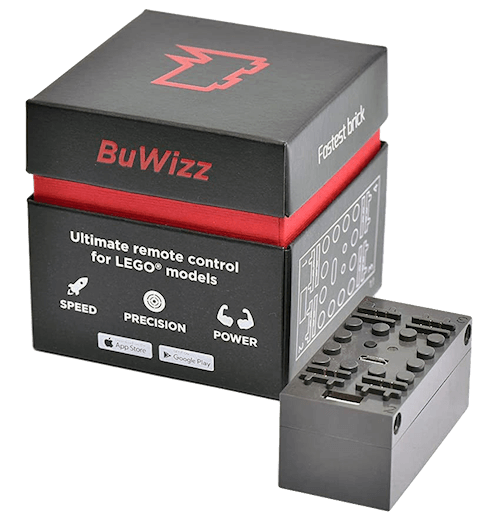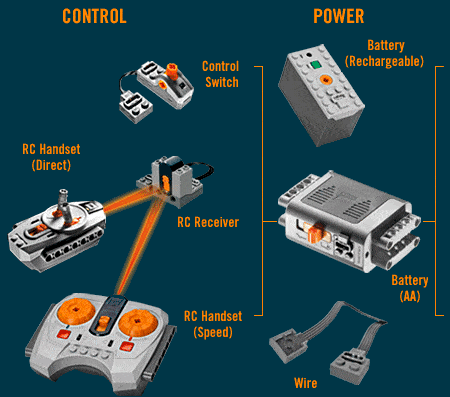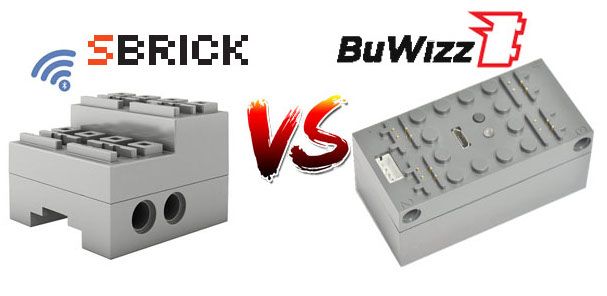
BuWizz is a compact four-channel Bluetooth controller brick for LEGO ® Power Functions. The third-party accessory features a powerful battery, which can be charged via a micro-USB cable. BuWizz is backward compatible with old LEGO devices e.g. RC-Buggy motors 5292 and forward compatible with all building components of LEGO Power Functions. Pair it with a phone or tablet to get your bricks moving.
BuWizz has first appeared on Kickstarter in 2016 and raised its target sum in just a few months. (yours truly was one of the project’s backers). The individuals who had pledged their money received the devices in February 2017. The successful release was followed by BuWizz 2.0 on November 27, 2017, and 2.0 version replaced the first version which no longer available on sale. BuWizz 2.0 have the long-anticipated Ludicrous Mode that provided the impressive 11.8 V in full charge, which is a bit higher than the officially declared value of 11.2 V.
I would be remiss if I didn’t mention how silly the device’s name is. Perhaps, in anticipation of fans’ questions, the producer issued the statement explaining what the name means. The explanation has only muddied the waters because according to it, “whizz” stands for the sound car models make, it also signifies “wizard,” and in the end, it’s up to fans to decide what it means. Go figure.
BuWizz Technical specs:
- 4 control channels; App supports up to 8 devices connection at the same time with 32 channels in total.
- Micro-USB charging (cable is not included);
- A power bank can charge the device or function as an additional battery for it;
- Wi-Fi Live stream camera support
- Voltage can be adjusted remotely on the go;
- Maximum current per channel is up to 3A (for BuWizz 2.0 it’s up to 4.5A); the maximum voltage is 9.2V (Fast speed mode) or whopping 11.2V (Ludicrous speed mode – in BuWizz 2.0 only);
- Lithium Polymer (Li-Ion) battery with the capacity of 7.5 Wh.;
- It takes only 65 min to charge the battery to 20-80% of its capacity and 120-180 min to 100%. The charge rate is 5W (5V, 1A).
- Operating temperature range is impressive -20C to + 60C;
- Dimensions: 3 bricks heights, 4 bricks width, and 8 bricks length, which is 1 brick shorter than the standard 8878 battery;
- Can serve as a replacement for a battery box, 2 IR receivers and remote controllers produced by LEGO PF;
- While the range of the first version of the controller is up to 50 meters, the second version adds 10 meters on top of that (it may vary depending on the controlled device).
An official user guide available here.
Buwizz vs SBrick Review
SBrick is another third-party controller used within the LEGO community. The accessory can be controlled via Bluetooth with the help of an iOS or Android app.
SBrick Technical specs:
- 4 control channels; supports control up to 16 SBrick simultaneously (64 channels)
- SBrick weighs 12.9 grams. Its dimensions are 32x32x24mm;
- Operating temperatures range from -20C to + 60C;
- While operating voltage is within the range of 4 to 10.8V, the maximum voltage goes up to 11.8V;
- The recommended operating current is up to 1A/channel. It can be increased up to 2A/channel with continuous loads. The maximum instantaneous current reaches 3A/channel;
- The range spreads up to 50 meters (it may vary depending on the controlled device);
- Custom settings can be user-created with Profile Designer;
- The smartphone/tablet app supports up to 4 SBrick at the same time (64 channels);
- Programmable via Scratch (only for SBrick Plus);
- Compatible with Lego NXT / EV3 sensors via an adapter and LEGO WeDo (only for SBrick Plus)
 To compare these devices, let’s take a serious model in terms of power consumption and design features. I’ve tested BuWizz on MOC-4874 BAJA TROPHY TRUCK. This model is not an official LEGO set, it’s a MOC (My Own Creation) from RM8. The model has 2 most powerful LEGO motors – RC-Buggy motors 5292 (produced till 2006). Buggy motors are used for driving, Servo-motor for steering. Control – 2 SBrick. Power supply – 2 LEGO Li-Po units.
To compare these devices, let’s take a serious model in terms of power consumption and design features. I’ve tested BuWizz on MOC-4874 BAJA TROPHY TRUCK. This model is not an official LEGO set, it’s a MOC (My Own Creation) from RM8. The model has 2 most powerful LEGO motors – RC-Buggy motors 5292 (produced till 2006). Buggy motors are used for driving, Servo-motor for steering. Control – 2 SBrick. Power supply – 2 LEGO Li-Po units.
To see how SBrick stacks up against BuWizz, I’ve used MOC-4874 BAJA TROPHY TRUCK – a substantial model both in terms of electric energy consumption and design details. It must be stated, however, that it’s a MOC by RM8, rather than an official kit. The truck features two heavy-duty RC-Buggy motors (released up to 2006), which are used for driving. The model also has a servo-motor steering mechanism and 2 SBricks for control. It is powered by 2 LEGO Li-Po batteries.
Before we go any further, let me explain the choice of not one but two SBricks. The thing is the current consumption of 2 RC-Buggy motors amounts to approximately 2.5 A. However, LEGO Li-Po unit has a protection circuit that switches on at only 1.3 A, thereby cutting the power off. To eliminate this issue, I used one Li-Po battery and one SBrick for each motor.
In this case, BuWizz is the perfect fit because it will eliminate the need for 2 batteries and SBricks, thereby reducing the truck’s weight by approximately 100 grams, which is not a trifling matter for high-speed performance. Furthermore, by hooking each motor up separately, I ensured that the protection circuit couldn’t go off, despite the fact that only one power supply was used. In my case, a single BuWizz effortlessly replaced 2 SBricks. Note that BuWizz can serve as a power source while one controls motors via a BuWizz-connected SBrick. In such an arrangement, custom control settings need to be deployed via Profile Designer. One also has to control LEDs individually and put in place sensors as well as other functions, which are currently missing in BuWizz app.
LEGO PF VS BuWizz Comparison
LEGO PF Technical specs:

- Control Range – 5-10 meters within sight for LEGO, BuWizz up to 50 meters (up to 60 BuWizz 2.0)
- Power. The Lego battery pack has a current limit of 1.3A (if the current is higher, protection is triggered), the receiver of the first version is up to 1.1A, (here you can see measurements and characteristics). Voltage – on new batteries it will be 9.6-9.7V, which is equivalent to BuWizz first version, but it already loses BuWizz 2.0 with 11.8V.
It is also worth noting that when the batteries are discharged, the voltage will gradually drop, after 5-10 minutes the voltage will become about 9.0-9.2V, when discharged to half, it will be 8.5V or lower (depending on the quality of the batteries). Of course, you can put AAA rechargeable batteries, but their voltage is lower – 1.2V, and in total you’ll get 7.2V and rechargeable batteries are heavier. The voltage on BuWizz will drop to 9.6-9.2V under load, and remain at least 9V until the full discharge. (11V for BuWizz 2.0) - Working time. This parameter is highly depends on the motors’ load. BuWizz can easily work for 30 minutes of continuous play with almost any MOC or motorized sets. More than an hour of continuous play under light load, for example, if you control sets like 42065 or 42095. The batteries will discharged in 20-30 minutes, and even after 10 minutes of play, the speed will drop significantly.
Purchase BuWizz or not – is it worth his money?
The BuWizz 2.0 regular price is $149. There’s no denying that the brick is anything but cheap. However, when its price is compared to that of similar offerings by Lego and SBrick+Lego, a different picture emerges.
| BuWizz | SBrick Controller + LEGO | LEGO |
| BuWizz 2.0 – $149 | SBrick – $59 (SBrick Plus – $79) | 8878 Rechargeable Battery Box – $50* |
| 8878 Rechargeable Battery Box – $50* | 45517 Transformer 10V DC – $33* | |
| 45517 Transformer 10V DC – $33* | IR Remote Control 8885 x2 – $20* | |
| 8886 Extension Wire – $3* | 8884 IR Receiver V1 x2 – $30* | |
| $149 | $145 | $133 |
*the prices in the table come from shop.lego.com for the US
Clearly, Buwizz’s price is quite reasonable, whereas its performance far exceeds the competition. To further emphasize this point, let’s sum up the total cost of equipping BAJA TROPHY TRUCK, discussed earlier, with electronics. When you throw together 2x SBrick, 2x Li-Po 8878, 2x 8886, and 1x Li-Po Charge 45517, the price amounts to whopping $257. That’s almost twice the price of BuWizz brick.
Bottom Line
If you ask me, BuWizz is a decent charge/controller unit for both MOC designers and professionals. You might also consider getting yourself one if you are putting together a model with the following specs:
- motors need to operate at higher power under considerable load;
- 4XL motor / 4L motor + additional Servo are utilized;
- the model has at least two RC-Buggy motors;
- none of above, but you want to get the most from your models’ speed and performance!
In cases described above, BuWizz is simply a perfect choice because it provides way more power than other units could do.


Thanks, I’ve recently been looking for information approximately this subject for a while and yours is the best I have come upon till now. However, what concerning the conclusion? Are you sure about the supply?
Yes, definitely.
Long time supporter, and thought I’d drop a comment.
Keep up the good work – and hope you all take care of yourself during
the coronavirus scare!